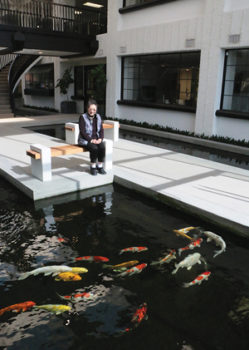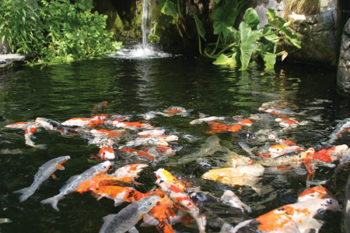
Most of us have witnessed this scenario. The pond is doing well, and the koi are really healthy. So, time for more koi, right? In go the new fish, and all is well for a week. But then, things turn ugly. Suddenly the koi look very sick, they don’t want to eat. If proper action is not taken, mortalities will follow.
This can happen to hobbyists and professionals alike. You obviously bought a sick fish, and now your inventory is in jeopardy, right? Well, more often than not, this scenario can be prevented before it ever happens. The key word here is “prevention.” Before getting into how to prevent fish disease, let’s re-evaluate our mindset on fish pathogens and disease in general.
Koi like stability in their environment. They get used to a certain set of water quality conditions and the existing microflora in the pond. This microflora includes non-pathogenic and pathogenic protozoa, algae, bacteria, viruses and fungi. Every pond environment contains an indigenous commensal flora population of diverse microorganisms growing in the water and colonizing the surface areas of the pond. They also grow on the filter media and colonize the outer surface of the fish’s skin.
This microflora may also contain populations of pathogenic microorganisms. Under normal circumstances, they do not pose an infection threat to fish. However, if one strain becomes paramount, the host’s resistance is reduced or the epithelial surface becomes broken, infection or infestation may develop. An established population of koi can adapt to the unique chemistry of a stable pond and develop an immunity to potential pathogens.
Pond Bugs
Fish have been dealing with parasites, bacteria, fungi and viruses since the dawn of fish. In a properly maintained ecosystem, fish like koi can develop immunity to most bugs. What we need to accept is the fact that these “bugs” are always present in our ponds and on our koi, to some degree. Our efforts to keep a clean, balanced pond help to reduce the numbers of these bugs to a level where the koi can develop a natural immunity.
In the next issue of POND Trade, I will go into greater detail on the quarantine protocol that we use and discuss "koi sleeping disease," a very common virus many of us have seen in our ponds, but perhaps without fully realizing what was actually going on with the koi.
However, these bugs can be kept in check by the immune system of the koi. Upset this natural immune balance, and the pathogens will increase in numbers. Even after a proper quarantine procedure with chemical treatment for parasites, the koi will still have bugs. You can’t sterilize a fish. In other words, koi may appear disease-free, but they are never completely free of pathogens.

Pathogenic and non-pathogenic bugs can thrive in dirty ponds. But even under the most disgusting conditions, I have seen established koi live without a pathogenic outbreak. When the pond was new, fish were introduced to clean conditions with what I call a low bug count. Over time, the water quality declines, and waste products build up, creating a terrible condition. The pathogenic and non-pathogenic bugs can then reproduce and increase exponentially. But somehow the koi continue to thrive, because they have had time to develop immunity to their gradually declining environment, with the bug count ever increasing. This is when you can really run into trouble adding new koi.
Whenever a new koi is introduced to an established pond, the immune balance will be compromised. Not only do the old koi pick up bugs from the new koi, but the new koi will also pick up bugs from the old koi. In a dirty pond with a high bug count, the chance of a pathogenic outbreak will increase.
>> Essential Tips for Taking Care of a Koi Pond
Everybody ends up sick, but the new koi always get the blame. It’s important to realize that the bugs go both ways. If you are a retailer of koi, you have likely witnessed this. A koi that you know to be very healthy and disease-free for many months or years dies when introduced to a hobbyist’s pond. Sometimes the rest of the customer’s old koi start to get sick, too. The new koi gets the blame, but it is very likely that the bug count in the pond was too high for the new koi’s immune system. Likewise, another environmental factor like pH or temperature may have been beyond the new koi’s ability to adjust.
So the bugs already in the pond then take advantage of this, reproducing rapidly on the new fish, which then stimulates increased virulence on the old fish, too. The new koi was already immune to its own bugs, but it forces the old koi to respond to these new bugs, too. Once again, the bugs go both ways, and we cannot sterilize a fish. But what we can do is reduce the number of bugs with preventive medicine and a clean environment. The fish can then more easily develop immunity, because there is a low number of bugs in a stress-free environment. When we medicate preventively, we are merely reducing the bug count, temporarily giving the immune system of all the koi, old and new, a fighting chance.
Once we accept the idea that pond fish always have bugs, good and bad, we can teach our customers the art of preventive treatment.
Proper Quarantine
The quarantine process should start in the dealer’s shop. Koi farmers are very diligent in quarantining and treating koi before shipping. However, a new shipment of koi will be weak and under stress from the shipping process, compromising their immune system. They need time to rest in warm, clean water conditions, where they can be treated preventively to keep pathogens in check.

It’s all about being proactive. Don’t wait for them to get sick before you treat them. The fish will need to be treated for flukes and other parasites. Know your gallons so you can treat properly. They may need salt therapy to help the gills stabilize for proper osmoregulation. Salt can also keep the mucus level low.
Large tanks will be required for this, because koi cannot be overcrowded during quarantine. A water temperature above 65 degrees is extremely important, because a koi’s immune response is poor in colder water. Their immune systems really start to kick in above 70 degrees.
Proper and restful quarantine should last at least two to three weeks. A conscientious dealer can also test for KHV exposure with the ELISHA test during this time.
When we medicate preventively, we are merely reducing the bug count, temporarily giving the immune system of all the koi, old and new, a fighting chance.
During this period, feeding should be monitored carefully. The filter needs to process the waste to keep the water quality high during this recovery period. But too much food too soon, and the koi’s gut will be overburdened. This will lead to an increased microflora count in the water, in the gut and on the skin and gills. I prefer to keep new koi on the hungry side during this initial period. The water quality and oxygen levels stay higher, and the koi’s natural defenses seem to recover more quickly on a lean diet. If they are not begging for food during this period, don’t feed them. And if they are begging, limit the quantities you feed them.
Develop and adhere to a quarantine protocol that works for you. There will always be room for improvement. Dealers and importers of koi will have variations in their quarantine protocol, but the end goals are the same. Reduce the stress from shipping, maintain high water quality, keep the gills in good condition, treat for common parasites and early signs of bacterial infection and test for viruses like KHV.
Treat the Whole Pond Again
Before introducing quarantined koi to your existing population, give the filter a good cleaning, remove or vacuum muck from the floor of the pond, make a water change and test the pH, KH, ammonia, nitrite and oxygen levels. Don’t add new koi to a dirty or poorly maintained ecosystem. Clear water is no clear indicator of water quality and bug count. Your existing koi have had a long time to adapt to the pond’s environment, so give the new koi a chance with improved maintenance.

Try not to add koi when the water temperature is below 65 degrees, because again, their immune response will be on the slow side. The best time to add koi to a pond is late spring through early fall. Once the pond is in check, add your koi and treat the whole pond preventively with a Malachite Green and Formalin combination and fluke medicine to keep things in check while the koi adapt to each other and the pond.
No water changes are necessary between each of these doses. These chemicals break down in less than 48 hours. A Malachite Green and Formalin combination is available under various brand names on the market. The fluke medicines that work best are praziquantel and flubendazole.
A koi dealer might feel uncomfortable suggesting that his customer treat the entire pond after a new koi purchase. The hobbyist may be suspicious that they are being sold a sick koi or that the dealer is just trying to upsell. But I can tell you that in my shop, my employees are instructed to explain this whole story to our customers, and they are typically very appreciative that we take the time to explain and help them be successful. They leave our shop with more knowledge and the ability to treat the pond correctly.
It certainly takes a lot of time to teach customers how to calculate the number of gallons in a pond, discuss water quality and proper filtration, and show them how to spot signs of a sick koi before it is too late. Most importantly, it takes time to get to know the customer and build relationships. Customers who treat preventively and correctly will be a lot more successful. The ones who don’t follow these steps may have a 50-percent chance that nothing bad will happen. Fifty-percent odds might be good in Las Vegas, but not with koi.
[box style=”rounded”]In the next issue of POND Trade, I will go into greater detail on the quarantine protocol that we use and discuss “koi sleeping disease,” a very common virus many of us have seen in our ponds, but perhaps without fully realizing what was actually going on with the koi.[/box]



looking forward to part 2!
It’s coming very soon. Watch for it the first week of July!